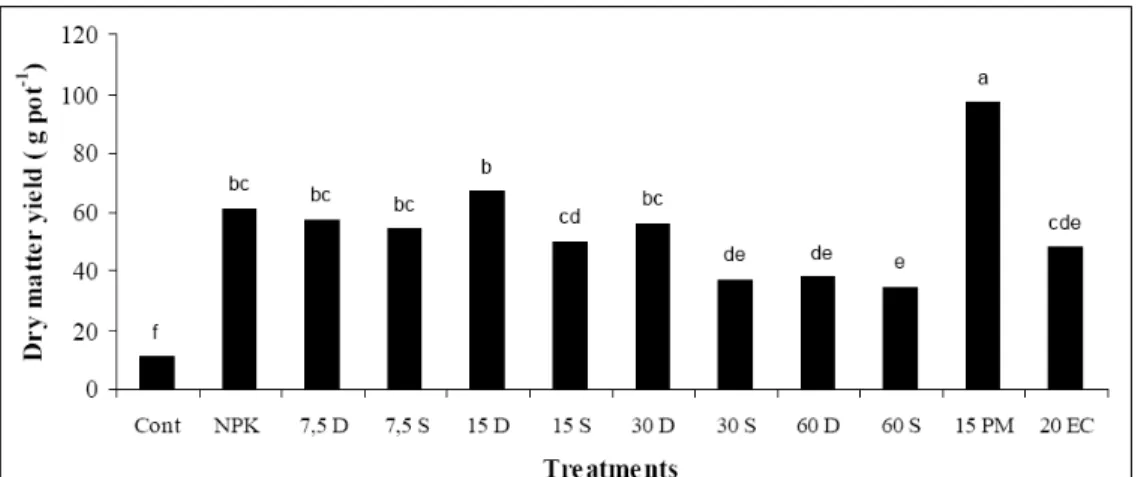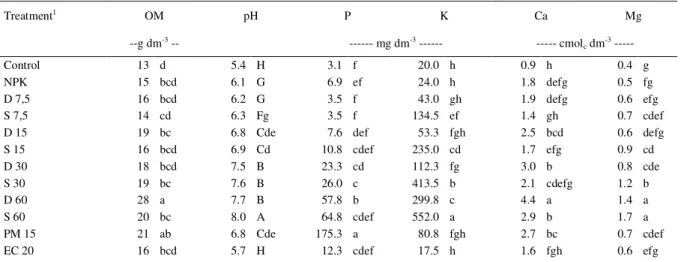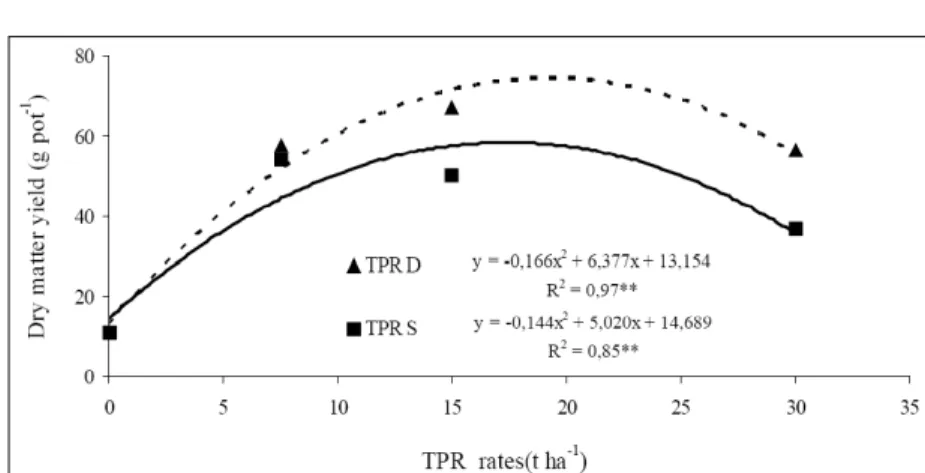ISSN 0103-8478
Marino José TedescoI Márcio Henrique LauschnerI Clesio GianelloI
Leandro BortolonI* Claudio Henrique KrayI
Land disposal potential of tobacco processing residues
Potencial de uso agrícola de dois resíduos de agroindústria fumageira
ABSTRACT
Brazil is one of the leaders in the production and trading of tobacco leaves in the global market, which results in a large amount of residues that would be recycled and used as soil fertilizers in agriculture. This research aimed to study the land disposal potential and agricultural use of tobacco processing residues (TPRs), their mineralization and the nutrient supply to the plants. The study was carried out in an open area using pots with 32dm3 of a sandy soil (Paleudult), provided
with water drainage collectors and tilled with three corn plants each. Eighteen treatments were tested with mineral fertilization, poultry manure (PM), earthworm compost (EC) and increasing rates (0, 7.5, 15, 30 e 60t ha-1) of TPR D (dust) and TPR S
(stem fibers).Treatments with TPRs (15t ha-1) plus mineral
supplementation two by two (NP, NK and PK) were also tested, with four replications each. The experiment started in 01/15/ 2004 and conducted until 03/16/2004, when corn plants were harvested. The response curves showed that the residues application rates between 15 and 20t ha-1 are most adequate
for the studied soil. The results indicated that both TPRs may be important sources of biomass and potash and have potential to be recycled in the soil, supplying part of the macronutrients required for proper plant growth.
Key words: nutrient cycling, nitrogen, water quality.
RESUMO
O Brasil é um dos maiores produtores e exportadores mundiais de tabaco em folha, resultando em grandes quantidaes de resíduos que poderiam ser utilizados como fertilizantes na agricultura. O objetivo deste trabalho foi avaliar o potencial de reciclagem agrícola de dois resíduos de agroindústria fumageira (RAF´s), sua mineralização no solo e liberação de nutrientes às plantas. O experimento foi conduzido a céu aberto utilizando como unidades experimentais vasos com capacidade de 32
litros de solo, adaptados com tubo coletor de lixiviado e um argissolo (PVAd), cultivado com três plantas de milho. Foram feitos 18 tratamentos com adubo mineral, cama-de-aviário, composto orgânico e com adição de doses crescentes (0, 7,5, 15, 30 e 60t ha-1) dos resíduos RAF P (pó) e do RAF T (talos),
além de tratamentos com resíduos (15t ha-1) e complementação
com nutrientes minerais dois a dois (NP, NK e PK), em quatro repetições. O experimento foi iniciado em 15/01/2004, tendo sido a parte aérea das plantas colhida em 16/03/2004. Foram avaliados o rendimento do milho e os atributos de fertilidade do solo após a colheita do milho, bem como o nitrogênio perdido por lixivição. Os resultados indicaram que os RAF´s são fontes de biomassa e de potássio e possuem potencial para serem reciclados no solo, permitindo a liberação de parte dos macronutrientes necessários ao desenvolvimento das plantas. As curvas de resposta indicaram que a adição de doses entre
15 e 20t ha-1 dos resíduos são a s mais recomendadas
agronomicamente no solo estudado.
Palavras-chave: reciclagem de nutrientes, fumo, qualidade da água.
INTRODUCTION
The use of agricultural soils for residues disposal has grown in importance all over the world, as far as the increasing population, production of residues and byproducts from human activities at urban centers. Land farming may have potential to recycle great part or even all energy and nutrient content of these residues. In fact, all of them may have potential to be recycled in soil and used to improve physical, chemical and biological soil attributes. However, it is necessary
IUniversidade Federal do Rio Grande do Sul (UFRGS), Av. Bento Gonçalves, 7712, 91540-000, Porto Alegre, RS, Brasil. E-mail:
to know their chemical content, mineralization rate and possible constraints for land disposal operations with these materials (TEDESCO et al., 1999; PAGE et al., 1985).
Brazil is one of the leaders in producing and trading tobacco leaves in the global market, with an amount of production over 800,000t annually (KBH & C, 2004). However, the industrial processing of tobacco leaves results in near 4% (35,000t per year) of byproducts with no commercial value at factories (KBH & C, 2004). The main byproducts of tobacco processing are dust (TPR D) and the stem fibers (TPR S), with nearly 95% and 5% of global amounts, respectively. The generation of dust (TPR D) and stem fibers (TPR S) depends mainly on leaves quality (e.g. position level on plants) and efficiency level of industrial processing unity. The major amounts of residues come from processing of Virginia Flue Cured (VFC) and Burley
tobacco varieties.
The objective was to study the recycling potential of two different tobacco processing residues (TPRs), their fertilizing value to the plants and effects on soil fertility attributes and water quality to fill the gap of information regards these residues for land disposal and nutrient source to crops.
MATERIAL AND METHODS
The study started in 01/15/2004 and finished 03/16/2004. The experiment was installed under environmental conditions at the Experimental Research Area of Soils Department (UFRGS), Porto Alegre, RS, Brazil. A sandy soil (Paleudult,USDA) with low natural fertility was used in the pots and its original chemical and physical characteristics were (0-20cm depth): clay = 140g dm-3; organic matter (OM) = 22g dm-3; pH water
= 5,5; P (Mehlich 1) = 4,7mg dm-3; K (Mehlich 1) = 42mg
dm-3; Ca (KCl 1mol L-1) = 2,9cmol
c dm-3; Mg (KCl 1 mol
L-1) = 1,5cmol
c dm-3 e CTCpH 7,0 = 7,3cmolc dm-3,
according to TEDESCO et al. (1995).
Pots made of PVC with 32dm3 of soil were
used as experimental units. They were provided with lateral needles connected to a plastic bottle (2dm3
capacity) to collect and store water drainage. Eighteen treatments were made with mineral N-P-K (urea, triple superphosphate and potassium chloride), poultry manure – PM (15t ha-1), earthworm compost – EC (20t
ha-1) and increasing rates equivalent to 0, 7.5, 15, 30
and 60t ha-1 of TPR D (dust) and TPR S (stem fibers).
The physical and chemical properties of the PM EC and TPR are showed in table 1.
Treatments with TPRs (15t ha-1) plus mineral
supplementation two by two (NP, NK and PK) were also tested. Nitrogen was split and applied along at 7, 21 and 35 days after seeding. The other mineral and organic supplementations were mixed with soil in the 0-25cm layer before seeding. Treatments were randomized in blocks with four replications. The residues used in this study were collected in April, 2003, at KBH & C factory unity in Vera Cruz-RS.
Each pot was tilled with three corn (Pioneer 30R21) plants. Irrigation was made twice a day to keep soil moisture adequate to corn growth. Corn shoots were harvested in 03/16/2004 and dried (60oC) during
72 h ours to deter min e dr y matter yield an d macronutrient (N, P, K, Ca and Mg) content, according to TEDESCO et al. (1995). Soil samples were taken in each treatment to determine pH, OM, P, K, Ca and Mg, according to TEDESCO et al. (1995). Leached water was frozen and later analyzed to determine NH4+ and
N-NO2
+ NO3
(Micro-Kjeldahl System), according to TEDESCO et al. (1995).
Table 1 - Physical and chemical properties of organic supplements(1)
---Organic material(3)
---Atribute (2)
TPR D TPR S PM EC
Moisture (%) 4.5 4.6 9.7 74.6
pH (H2O) 6.5 5.1 7.7 7.3
Organic C (%) 28.6 33.4 30.6 28.0
N (TKN) (%) 1.9 1.9 1.8 1.8
P (%) 0.29 0.28 1.1 0.62
K (%) 2.5 6.7 1.9 0.62
Ca (%) 3.3 1.5 8.1 1.6
Mg (%) 0.69 0.71 0.55 0.46
S (%) 0.38 0.38 0.40 0.53
Fe (%) 0.95 0.03 0.11 0.54
Cu (mg kg-1) 24 7 61 46
Zn (mg kg-1) 64 29 454 221
Mn (mg kg-1) 699 125 448 885
Na (mg kg-1) 720 1600 7600 1100
B (mg kg-1) 29 24 17 20
C/N ratio 15 18 17 16
(1) According to Tedesco et al. (1995). (2) Expressed on dry matter
basis (75 oC) except pH value. (3) TPR D = tobacco processing
The data were analyzed by analysis of variance (ANOVA) to test the treatments effect. The differences among the treatments were evaluated by the Tukey test with 5% of probability.
RESULTS AND DISCUSSION
All treatments with addition of organic and/ or mineral supplementation showed higher corn dry matter yields when compared to soil control (Figure 1). Treatments with increasing addition rates until 15t ha-1
of TPR S and until 30t ha-1 of TPR D produced crop
response significantly similar to treatments with mineral NPK and with 20t ha-1 of earthworm compost (EC).
The increase of dry matter yield was around 500%, showing the low natural soil fertility and the fertilizing potential of the TPRs. The treatment supplemented with poultry manure (PM) showed the highest dry matter yield. This probably was due the high residue mineralization rate, which was linked with the P supplied via PM that showed the highest soil P amounts at the end of the study (Table 2).
The corn growth response to PM treatment was already observed at the second week after seeding, while TPR D and TPR S treatments responses were detected only after the third and fourth weeks, respectively. This pattern was even more evident on treatments with 60t ha-1 of residues, whose plants with
TPR showed very low initial growth and symptoms of phosphorus and nitrogen deficiencies. This was possibly due to the low nutrient mineralization rates as effect of the large amount of residues applied to the
soil. A rise in plants development was observed along the growth period. Therefore, plants under nutrition deficiency in early growth stages, hardly recover their normal growth pattern and presents early maturation and poor yields (TISDALE et al., 1993).
Dry matter yields of treatments with addition of 15t ha-1 of TPRs plus mineral supplementation with
NP, NK and PK are showed in figure 2. There were not significantly differences among treatments with and without mineral fertilizers. However, it can be observed that the treatments with mineral P addition showed the tendency to higher dry matter responses. This was even more evident on treatments with TPR S. LAUSCHNER et al. (2004), which worked with the same type of soil and different organic materials and observed that P deficiency was the main constraint to oat plants. The dry matter response curves determined with increasing addition rates until 30t ha-1 of TPRs are
shown on figure 3. The 60t ha-1 was not used in the
relationship because plants showed very low initial growth and symptoms of phosphorus and nitrogen deficiencies. The response curves were different, depending on each TPR and rate. Maximum technical efficiency (MTE) was calculated by using quadratic regression equation resulting in 17,7t ha-1 and 19,3t ha-1
for TPR D and TPR S, respectively. These results were similar to those found by CZECKATA et al. (2002) who worked with tobacco waste addition as nitrogen source to plants. However, quadratic response curves tend to overestimate points of maximum response value.
The tendency to higher OM content in soil was determined with increasing rates of TPRs (Table 2).
Treatments with higher rates showed gains over 200% compared with the control group. However, the most part of organic matter content probably are easily decomposable. It was observed that pH values increased as additional rates of TPRs were applied. The increase of pH could be due the alkaline reaction of the residue during the composition; this fact might be a problem if high amounts without control are applied in soil. Further studies regarding the biochemical composition of these residues and it´s mineralization process are needed to fill the gap about the alkaline effect. TPR S showed a higher alkaline effect tendency compared to TPR D. Generally, N (OM), P, K, Ca, Mg and soil pH increased with addition of TPRs to the soil.
Calcium and potassium gains were even more evident in treatments with TPR D and TPR S, probably due the high amount of it, which was related to the high mineralization rate, respectively.
Nitrate (NO2- + NO 3
-) levels in leached water
were all similar to the control and NPK treatments (Table 3). However, amoniacal nitrogen in the water leached from the 60 t ha-1 TPR S treatment was much higher than any
other. This was attributed to low soil CEC, alkaline effect of residues and large amounts of N and K in this treatment (PAGE et al., 1985). Moreover, the physical characteristics of stem fibers may have increased water flow through the soil.
Figure 2 - Corn shoots dry matter yield related to treatments with addition of 15t ha-1 TPRs (D-dust and
S-stem fibers) plus mineral amendments. Means followed by same letter are not different according Tukey Test (P<0,05).
Table 2 - Soil fertility attributes after corn harvesting (means of four replications).
Treatment1 OM pH P K Ca Mg
--g dm-3 -- --- mg dm-3 --- --- cmol
c dm-3
---Control 13 d 5.4 H 3.1 f 20.0 h 0.9 h 0.4 g
NPK 15 bcd 6.1 G 6.9 ef 24.0 h 1.8 defg 0.5 fg
D 7,5 16 bcd 6.2 G 3.5 f 43.0 gh 1.9 defg 0.6 efg
S 7,5 14 cd 6.3 Fg 3.5 f 134.5 ef 1.4 gh 0.7 cdef
D 15 19 bc 6.8 Cde 7.6 def 53.3 fgh 2.5 bcd 0.6 defg
S 15 16 bcd 6.9 Cd 10.8 cdef 235.0 cd 1.7 efg 0.9 cd
D 30 18 bcd 7.5 B 23.3 cd 112.3 fg 3.0 b 0.8 cde
S 30 19 bc 7.6 B 26.0 c 413.5 b 2.1 cdefg 1.2 b
D 60 28 a 7.7 B 57.8 b 299.8 c 4.4 a 1.4 a
S 60 20 bc 8.0 A 64.8 cdef 552.0 a 2.9 b 1.7 a
PM 15 21 ab 6.8 Cde 175.3 a 80.8 fgh 2.7 bc 0.7 cdef
EC 20 16 bcd 5.7 H 12.3 cdef 17.5 h 1.6 fgh 0.6 efg
1Means followed by same letter in columns are not different according Tukey Test (P<0,05) NPK (urea, triple superphosphate and potassium
chloride); PM - poultry manure (15t ha-1); EC - earthworm compost (20t ha-1) and increasing rates equivalent to 0, 7.5, 15, 30 and 60t ha-1 of
CONCLUSION
The results indicated that both TPRs may be important sources of biomass and potassium and have potential to be recycled in the soil, supplying part of the macronutrients required for a proper plant growth. However, potassium and nitrogen contents and soil alkaline effects may limit agronomic application rates and need to be carefully observed and monitored in possible field land disposals. The results suggested that the application cannot be held in cropping system with brown gap, because this system provides conditions that facilitate nitrogen losses by leaching.
A cropping system with continuous plant growth is required to avoid problems with nitrogen losses in surface and ground surface waters.
ACKNOWLEDGEMENTS
The authors fully thanks the Ministério da educação (MEC), Coordenação de Aperfeiçoamento de Pessoal de Nível Superior (CAPES), Conselho Nacional de Desenvolvimento Científico e Tecnológico (CNPQ) – Brazilian National Research Council; Soil, Plant, Waste and water Analysis Laboratory – Universidade Federal do Rio Grande do Sul (UFRGS) – Porto Alegre – RS – Brazil; KANNENBERG CIA LTDA and KBH & C; UNIFERTIL S.A.
Figure 3 - Response curves of corn shoots dry matter yield with increasing TPRs rates (D-dust and S-stem fibers).
Table 3 - Total volume and mineral nitrogen in leached water (means of four replications).
Treatment Water volume NH4 NO2 + NO3
--- mL --- --- mg L-1
---Control 3338 Cdef 0.21 b 18.34 bcd
NPK 2695 Fgh 0.87 b 26.27 abc
D 7,5 2298 Hi 0.63 b 34.46 a
S 7,5 2595 Gh 0.35 b 16.28 bcd
D 15 2960 defgh 1.90 b 22.25 abcd
S 15 3573 Abcde 2.17 b 26.22 abc
D 30 2940 Defgh 2.20 b 25.59 abc
S 30 4103 Abc 7.45 b 30.91 ab
D 60 2613 Gh 3.08 b 15.04 cd
S 60 4233 Ab 154.79 a 7.82 d
PM 15 3470 Bcdef 0.41 b 8.74 d
EC 20 1700 I 0.29 b 19.04 bcd
1Means followed by same letter in columns are not different according Tukey Test (P<0,05) NPK (urea, triple superphosphate and potassium
chloride); PM - poultry manure (15t ha-1); EC - earthworm compost (20t ha-1) and increasing rates equivalent to 0, 7.5, 15, 30 and 60t ha-1 of
REFERENCES
CZECKATA, J. et al. The utilization of tobacco dust as a source of nitrogen for plants and of carbon for the formation of humus compounds in soil. In: _____. Recycling of agricultural, municipal and industrial residues in agriculture. 10.ed. Slovak Republic:Strbske Plesos, 2002. Cap.5, p.75-102.
KBH & C. Coordenação de processos industriais. Vera Cruz: KBH & C, 2004. 52p. (Comunicado Técnico). LAUSCHNER, M.H. et al. Valor fertilizante de resíduos orgânicos e adubos minerais em um Argissolo Vermelho-Amarelo distrófico (PVAd). In: FERTBIO, 26., 2004, Lages, SC. Anais…
Lages: Universidade do Estado de Santa Catarina, 2004. CD.
PAGE A.L. et al. Utilization, treatment and disposal of waste on land. Wisconsin: Soil Science Society of America, 1985. 485p.
TEDESCO, M.J. et al. Análises de solos, plantas e outros materiais. 2.ed. Porto Alegre: Departamento de solos, UFRGS, 1995. 174p. (Boletim Técnico, 5).



